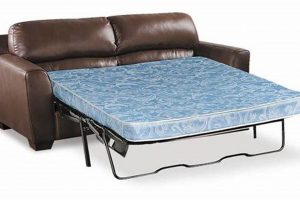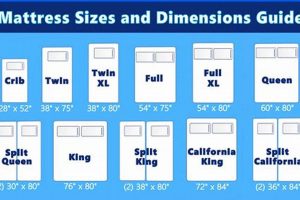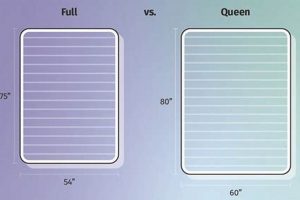A standard full mattress, also known as a double mattress, typically measures approximately 54 inches in width and 75 inches in length. These dimensions provide a sleeping surface suitable for a single adult or potentially two smaller individuals. The rectangular shape is designed to fit within standard bed frames designated for this specific mattress type.
The popularity of this mattress stems from its balance between affordability and usability. It offers more sleeping space than a twin mattress, making it a viable option for individuals who require extra room to stretch out. Historically, the full mattress gained prominence as living spaces became smaller and more compact, requiring furniture options that efficiently utilize available space. Its widespread adoption reflects a practical solution to bedroom furnishing needs.
Understanding these standard dimensions is crucial when selecting bedding accessories, such as sheets and comforters, and when planning bedroom layouts to ensure the mattress fits comfortably within the available space and selected bed frame. Subsequent sections will delve into considerations for choosing the right mattress depth, comparing it to other mattress sizes, and addressing common questions related to its use.
Selecting a Full Mattress
The following provides guidance for choosing a full mattress based on its dimensions and intended use.
Tip 1: Assess Room Dimensions: Prior to purchase, accurately measure the bedroom space to ensure adequate clearance around the mattress. A full mattress, at 54 inches by 75 inches, can dominate smaller rooms, hindering movement.
Tip 2: Consider Occupancy: A full mattress is often adequate for a single sleeper. However, for couples, the available width may prove restrictive, impacting sleep quality.
Tip 3: Evaluate Body Size: Taller individuals may find the 75-inch length insufficient, potentially leading to discomfort. Alternative sizes, such as a queen or king, might offer better support.
Tip 4: Account for Bed Frame Dimensions: Full-size bed frames typically add several inches to the overall footprint. Verify that the combined dimensions align with available space.
Tip 5: Anticipate Future Needs: If future changes in sleeping arrangements are anticipated (e.g., transitioning from a single sleeper to a couple), a larger mattress size may be a more pragmatic investment.
Tip 6: Weight Considerations: Ensure the selected mattress foundation or bed frame can adequately support the combined weight of the mattress and the occupants. Exceeding weight limits can compromise support and durability.
Adhering to these guidelines when considering the dimensions of a full mattress can facilitate a more informed purchasing decision, optimizing comfort and usability within the intended environment.
Subsequent sections will explore specific mattress types and their suitability for various sleep preferences and needs.
1. Standard Width
The specification of 54 inches as the standard width is a defining characteristic when considering “what is the size of a full mattress.” This dimension directly impacts the comfort level, suitability for different body types, and the overall spatial requirements within a bedroom.
- Comfort and Personal Space
The 54-inch width offers a moderate amount of personal space for a single sleeper. This allows for some movement and repositioning during sleep. However, it may be insufficient for individuals who prefer a more expansive sleeping surface or who tend to move considerably during the night. Consequently, the 54-inch width represents a compromise between space efficiency and individual comfort.
- Suitability for Couples
While technically capable of accommodating two adults, the 54-inch width provides only 27 inches of personal space per person. This limited space can lead to discomfort, restricted movement, and potential sleep disturbances, particularly for individuals accustomed to more spacious sleeping arrangements. Therefore, a full mattress may be less suitable for couples compared to larger options like queen or king sizes.
- Spatial Considerations in Room Design
The 54-inch width is a critical factor in determining the optimal placement of a full mattress within a bedroom. It influences the amount of floor space remaining for other furniture, as well as the overall flow and usability of the room. Accurate measurement and careful planning are essential to ensure the mattress integrates seamlessly into the room’s layout without creating a sense of overcrowding.
- Compatibility with Bedding and Accessories
The standardized 54-inch width ensures compatibility with a wide range of bedding accessories, including sheets, comforters, and mattress protectors specifically designed for full-size mattresses. This standardization simplifies the purchasing process and ensures a proper fit, preventing issues such as excessive fabric overhang or insufficient coverage.
In summary, the 54-inch width is a fundamental aspect that defines the utility and appropriateness of a full mattress. Its influence extends from individual comfort levels to room design considerations, highlighting the importance of understanding this dimension when evaluating if a full mattress aligns with specific needs and preferences. The 54-inch width of “what is the size of a full mattress” also facilitates market standardization of accessories and parts.
2. Standard Length
The dimension of 75 inches for standard length directly determines the suitability of a full mattress for individuals of varying heights. As a core component, this length works in conjunction with the 54-inch width to define the overall sleeping surface. Insufficient length can lead to discomfort, particularly for individuals exceeding approximately six feet in height, as their feet may extend beyond the mattress edge. This compromises proper spinal alignment and can disrupt sleep patterns. For instance, an individual who is 6’2″ (74 inches) would have minimal margin and could experience reduced sleep quality due to this constraint.
Conversely, the 75-inch length contributes to efficient space utilization in smaller bedrooms, aligning with the overall design intent of a full mattress. The limited length allows for placement in rooms where a queen or king mattress would prove impractical. Hotel rooms, guest rooms, or apartments often utilize mattresses of this size due to spatial constraints. This dimensional consideration has a practical impact on furnishing choices and interior design layouts. Moreover, this standard facilitates manufacturing and distribution by providing a consistent benchmark for bedding accessories.
In conclusion, the standard length of 75 inches is integral to “what is the size of a full mattress”, influencing both user comfort and spatial efficiency. While suitable for many individuals, it presents limitations for taller users. Understanding this dimension allows for informed purchasing decisions and contributes to optimized sleep quality. Failing to account for this metric can lead to discomfort and dissatisfaction, emphasizing its practical significance.
3. Surface Area
The calculation of surface area, yielding approximately 4050 square inches, is directly derived from the defining dimensions of a standard full mattress, and elucidates the scope of the sleeping space provided. This figure contextualizes the mattress’s utility and suitability for various users.
- Sleeping Space Adequacy
The 4050 square inch surface area dictates the amount of room available to a sleeper. For single individuals, this space provides ample room to move and adjust position throughout the night. However, when shared by two adults, this area can become restrictive, potentially leading to discomfort and disrupted sleep due to limited personal space.
- Comparison to Other Mattress Sizes
Quantifying surface area allows for a direct comparison with other mattress sizes. A queen mattress, for example, offers a significantly larger surface area, providing more space for individual sleepers or couples. Conversely, a twin mattress offers considerably less surface area, making it less suitable for adults. Comparing these figures emphasizes the practical implications of the specific dimensions comprising a full mattress.
- Impact on Bedding Selection
The surface area influences the selection of appropriate bedding. Sheets, comforters, and mattress protectors must be sized to adequately cover the 4050 square inch surface. Incorrectly sized bedding can lead to discomfort and reduced protection of the mattress itself. Therefore, understanding this value is crucial for proper outfitting of the bed.
- Relationship to Room Size
While the 4050 square inch surface area represents the sleeping surface, the overall footprint of the mattress within a room extends beyond this figure when accounting for the bed frame. This consideration influences the perceived spaciousness of a bedroom. Larger rooms can more comfortably accommodate a full mattress, while smaller rooms may feel cramped as a result.
In summary, the 4050 square inch surface area of a full mattress, determined by its dimensions, impacts comfort, comparability, bedding selection, and spatial considerations. This figure serves as a quantitative measure of the mattress’s utility and underlines the significance of each dimension to what is the size of a full mattress.
4. Suitable Room Size
The designation of “medium” as the suitable room size for a full mattress reflects a practical assessment of spatial requirements dictated by the dimensions of the mattress. The correlation between mattress size and room size is crucial for optimizing both comfort and functionality within a bedroom.
- Spatial Efficiency and Movement
A medium-sized room, when accommodating a full mattress, typically allows for sufficient space around the bed for movement and placement of other furniture. This contrasts with smaller rooms where a full mattress could significantly restrict available space, impeding navigation and creating a sense of confinement. For example, a room measuring 10 feet by 12 feet would be considered a reasonable fit, allowing for a nightstand and walking space.
- Furniture Placement and Ergonomics
The “medium” room size enables ergonomic furniture placement around the full mattress. Nightstands, dressers, and other essential items can be positioned at comfortable distances, contributing to the overall functionality and aesthetic appeal of the space. In smaller rooms, furniture placement may be constrained, compromising convenience and comfort. A medium-sized room allows for a more deliberate arrangement, fostering a more functional layout.
- Visual Balance and Aesthetics
A full mattress positioned within a medium-sized room typically achieves a visually balanced aesthetic. The mattress occupies a reasonable proportion of the floor space without overwhelming the room’s overall dimensions. This balance contributes to a more pleasing and harmonious atmosphere, avoiding the cramped feeling associated with larger mattresses in smaller rooms or the sparse feeling of smaller mattresses in larger rooms.
- Impact on Other Room Features
The choice of a full mattress in a medium-sized room preserves the capacity to incorporate other room features. Elements such as desks, seating areas, or storage solutions can be integrated without compromising the room’s core function as a sleeping space. This adaptability is a key benefit of aligning mattress size with room dimensions, facilitating a multi-functional environment if needed.
The concept of “medium” room size, therefore, is inextricably linked to “what is the size of a full mattress”, shaping considerations regarding spatial utilization, ergonomic design, visual aesthetics, and overall room functionality. Recognizing this interrelationship is crucial for making informed decisions about mattress selection and bedroom arrangement.
5. Sleeping Capacity
The designation of a full mattress as having a sleeping capacity of “One/Two” is a direct consequence of its dimensional specifications, influencing its suitability for single occupancy or shared sleeping arrangements. Understanding this capacity, intrinsically tied to “what is the size of a full mattress,” requires a nuanced evaluation of the spatial limitations and comfort implications involved.
- Single Occupancy Comfort
For a single sleeper, a full mattress provides a reasonable amount of personal space, allowing for freedom of movement and position adjustments during sleep. The 54-inch width offers sufficient area for most individuals to stretch out and maintain a comfortable posture. This contrasts with a twin mattress, which may feel restrictive for some adults. Therefore, the “one” aspect of its sleeping capacity reflects a pragmatic solution for single individuals who require more space than a twin mattress offers.
- Suitability for Couples: Spatial Constraints
While technically capable of accommodating two individuals, the “two” aspect of its sleeping capacity necessitates careful consideration. Sharing a 54-inch wide mattress provides each person with approximately 27 inches of personal space, which is less than the width of a twin bed. This limited space can lead to discomfort, disrupted sleep cycles, and reduced overall sleep quality. Consequently, the suitability of a full mattress for couples depends on individual preferences, sleeping habits, and tolerance for close proximity during sleep.
- Impact on Sleep Quality and Disturbance
The limited space available on a full mattress when shared by two individuals can contribute to sleep disturbances. Movements of one sleeper are more likely to be felt by the other, potentially leading to interruptions in sleep cycles and reduced restorative sleep. This factor is particularly relevant for individuals who are sensitive to movement or who have significantly different sleep schedules. The potential for sleep disturbance highlights the spatial limitations associated with the “two” aspect of its sleeping capacity.
- Alternative Options and Considerations
Given the limitations of a full mattress for couples, alternative mattress sizes, such as queen or king, often represent more suitable options. These larger mattresses provide significantly more personal space for each sleeper, mitigating the potential for discomfort and sleep disturbance. The decision to opt for a full mattress for two individuals should be weighed against the benefits of larger alternatives and a realistic assessment of the potential impact on sleep quality. Other factors to consider are room dimensions and budget which may influence the final mattress choice.
In conclusion, the designated sleeping capacity of “One/Two” for a full mattress is directly tied to “what is the size of a full mattress”, specifically its dimensions. While viable for single occupancy, its suitability for couples is contingent upon individual factors and a recognition of the potential spatial constraints and their impact on sleep quality. Considering these elements ensures a more informed decision when selecting a mattress based on anticipated occupancy and personal needs.
Frequently Asked Questions
The following addresses common inquiries regarding the dimensional specifications and practical applications of full mattresses.
Question 1: What are the precise measurements that define what is the size of a full mattress?
A standard full mattress measures approximately 54 inches in width and 75 inches in length. These dimensions are the industry norm, though minor variations may occur depending on the manufacturer.
Question 2: Is a full mattress suitable for two adults?
While technically capable of accommodating two adults, a full mattress offers limited personal space, potentially impacting sleep quality. Couples may find a queen or king mattress more comfortable due to the increased sleeping surface.
Question 3: What is the ideal room size for a full mattress?
A medium-sized room is generally considered appropriate for a full mattress. This allows for adequate space around the bed for movement and placement of other furniture. Smaller rooms may feel cramped with a full-sized mattress.
Question 4: How does a full mattress compare to a twin mattress in terms of size?
A full mattress is wider and longer than a twin mattress. A full mattress measures 54 inches wide, while a twin mattress typically measures 38 inches wide. The increased width makes a full mattress more suitable for adults who require additional sleeping space.
Question 5: Are full-size bedding accessories readily available?
Yes, full-size bedding accessories, such as sheets, comforters, and mattress protectors, are widely available from most retailers that sell bedding products. The standardized dimensions ensure compatibility with a broad range of accessories.
Question 6: What are the primary advantages of choosing a full mattress?
The primary advantages include its affordability, suitability for single adults, and efficient use of space in medium-sized bedrooms. It offers a compromise between the smaller twin size and the larger queen or king sizes.
In summary, the dimensions of a full mattress dictate its suitability for various sleeping arrangements and room sizes. Understanding these specifications is crucial for making informed purchasing decisions.
The subsequent section will provide guidance on selecting the appropriate mattress type based on individual sleep preferences and needs.
Understanding Full Mattress Dimensions
The preceding discussion elucidates the significance of “what is the size of a full mattress.” The dimensions, approximately 54 inches in width and 75 inches in length, define its suitability for single sleepers, spatial efficiency within medium-sized rooms, and overall utility. These specific measurements influence comfort, bedding selection, and the mattress’s practicality compared to other sizes. A careful consideration of these aspects facilitates informed decision-making for consumers.
Recognizing these dimensional implications serves as a foundation for optimizing sleep quality and bedroom functionality. Continued awareness of evolving mattress technologies and personal sleeping needs will further contribute to selecting the most appropriate sleeping surface. A thorough understanding of what constitutes “what is the size of a full mattress” will enable readers to align bedding choices with their individual preferences.







